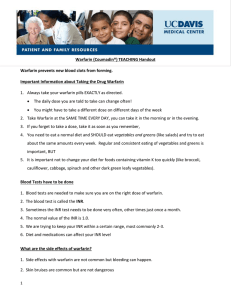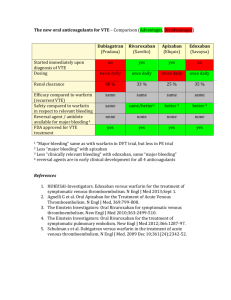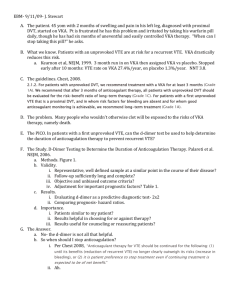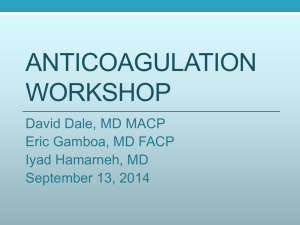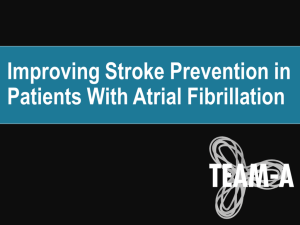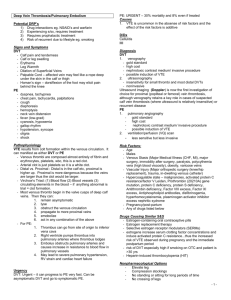Antithrombotic Therapy for VTE: CHEST Guidelines 2016 Jennifer Mah, MD March 2016
advertisement
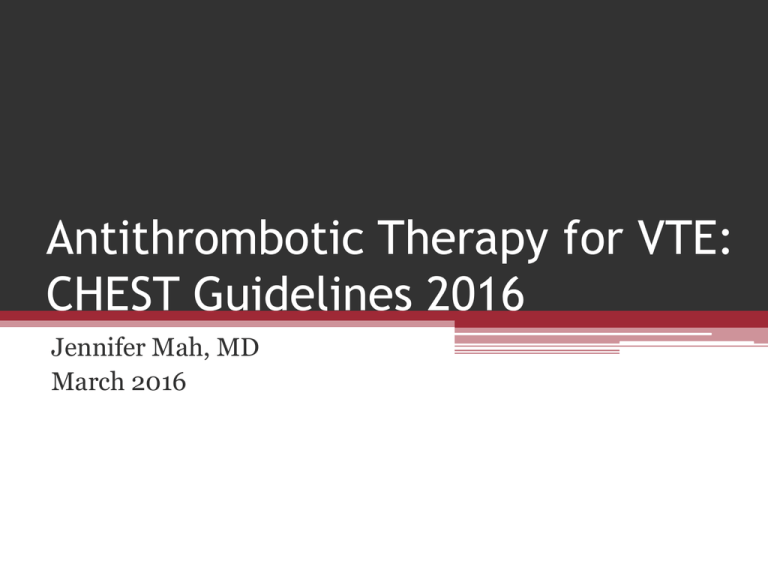
Antithrombotic Therapy for VTE: CHEST Guidelines 2016 Jennifer Mah, MD March 2016 Case A 44-year-old man is evaluated in follow-up for an episode of unprovoked left proximal leg deep venous thrombosis 3 months ago. Following initial anticoagulation with lowmolecular-weight heparin, he began treatment with warfarin. INR testing done every 3 to 4 weeks has shown a stable therapeutic INR. He has mild left leg discomfort after a long day of standing, but it does not limit his activity level. He tolerates warfarin well. Family history is unremarkable, and he takes no other medications. Which of the following is the most appropriate management? A. Continue anticoagulation indefinitely B. Discontinue warfarin in another 3 months C. Discontinue warfarin now D. Discontinue warfarin and perform thrombophilia testing Objectives • • • • Recognize subgroups of VTE Review medications for VTE anticoagulation Learn guidelines for duration of therapy Understand differences in therapy based on type of VTE Subgroups of VTE • • • • Cancer-associated vs No cancer Provoked vs Unprovoked Proximal vs Distal DVT Upper extremity vs Lower extremity DVT VTE and No Cancer • Use NOAC – preferred! (Grade 2B) ▫ Rivaroxaban, apixaban No bridging needed ▫ Dabigatran, edoxaban Start with parenteral anticoagulation x5 days • If contraindications to NOAC, then use VKA therapy (warfarin) (Grade 2C) ▫ Overlap with parenteral anticoagulation x5 days, ▫ And INR >2 for 24 hours Contraindications to NOACs • Extreme BMI (>40) • CrCl <30 • Significant increased risk of bleeding Cancer-Associated Thrombosis • Use LMWH (Grade 2C) ▫ Enoxaparin 1 mg/kg/dose BID Provoking Transient Risk Factors for VTE • • • • • Surgery Estrogen therapy Pregnancy Leg injury Flight >8h Location of VTE • Lower extremity DVT ▫ Proximal – Popliteal or more proximal veins ▫ Distal – Calf veins • Upper extremity DVT ▫ Proximal – Axillary or more proximal veins ▫ Catheter-associated Duration of Therapy Isolated Distal DVT Proximal DVT or PE Unprovoked Provoked 3 months (Grade 1B) Low bleeding risk Extended therapy (first VTE Grade 2B, second VTE Grade 1B) Mod bleeding risk Extended therapy (first VTE Grade 2B, second VTE Grade 2B) High bleeding risk 3 months (first VTE Grade 1B, second VTE Grade 2B) Mild symptoms or high bleeding risk Serial imaging x2 weeks (Grade 2C) Extending thrombus Anticoagulate (Grade 1B, 2C) Severe symptoms or risk for extension Anticoagulate (Grade 2C) Cancerassociated Upper extremity DVT Extended therapy Anticoagulate (Grade 1B) (Grade 2C) Special Considerations for Upper Extremity DVT Catheterassociated Proximal Catheter functional? Anticoagulate Yes Catheter still needed? Yes Leave catheter in and anticoagulate No No Remove and anticoagulate x3 months Risk Factors for Bleeding on Anticoagulant Therapy • • • • • • • • • • Age >65 Age >75 Previous bleeding Cancer Metastatic cancer Renal failure Liver failure Thrombocytopenia Previous stroke Diabetes • • • • • • • • Anemia Antiplatelet therapy Poor anticoagulant control Comorbidity and reduced functional capacity Recent surgery Frequent falls Alcohol abuse NSAID use Low risk 0 risk factors Moderate risk 1 risk factor High risk ≥2 risk factors Risk Factors for Extension of Distal DVT • Positive D-dimer • Extensive thrombus ▫ >5cm long, involves multiple veins, >7mm diameter • • • • • Thrombus close to proximal veins No reversible provoking factor Active cancer History of VTE Inpatient status What if my patient stops anticoagulation? • Aspirin is NOT a reasonable alternative to anticoagulation for extended therapy ▫ Much less effective at preventing recurrent VTE • However, aspirin is better than nothing (Grade 2B) Recurrent DVT on Anticoagulation • If on therapeutic warfarin or NOAC, then switch to enoxaparin temporarily (minimum 1 month) (Grade 2C) ▫ Is this really recurrent VTE? ▫ Is my patient compliant with therapy? ▫ Is there underlying malignancy? • If on enoxaparin and compliant, then increase the dose by 25-33% (Grade 2C) Case Revisited A 44-year-old man is evaluated in follow-up for an episode of unprovoked left proximal leg deep venous thrombosis 3 months ago. Following initial anticoagulation with lowmolecular-weight heparin, he began treatment with warfarin. INR testing done every 3 to 4 weeks has shown a stable therapeutic INR. He has mild left leg discomfort after a long day of standing, but it does not limit his activity level. He tolerates warfarin well. Family history is unremarkable, and he takes no other medications. Which of the following is the most appropriate management? A. Continue anticoagulation indefinitely B. Discontinue warfarin in another 3 months C. Discontinue warfarin now D. Discontinue warfarin and perform thrombophilia testing Duration of Therapy Proximal DVT or PE Provoked 3 months Isolated Distal DVT Unprovoked Low to moderate bleeding risk Extended therapy High bleeding risk Mild symptoms or high bleeding risk Severe symptoms or risk for extension Serial imaging x2 weeks Anticoagulate 3 months Extending thrombus Anticoagulate Cancerassociated Upper extremity DVT Extended therapy Anticoagulate Case Revisited A 44-year-old man is evaluated in follow-up for an episode of unprovoked left proximal leg deep venous thrombosis 3 months ago. Following initial anticoagulation with lowmolecular-weight heparin, he began treatment with warfarin. INR testing done every 3 to 4 weeks has shown a stable therapeutic INR. He has mild left leg discomfort after a long day of standing, but it does not limit his activity level. He tolerates warfarin well. Family history is unremarkable, and he takes no other medications. Which of the following is the most appropriate management? A. Continue anticoagulation indefinitely B. Discontinue warfarin in another 3 months C. Discontinue warfarin now D. Discontinue warfarin and perform thrombophilia testing Summary • NOACs are preferred over warfarin for anticoagulation • Except if VTE is cancer-associated, then use enoxaparin • Duration of therapy is usually 3 months, with extended therapy based on risk factors for recurrent VTE References • Kearon C, Akl EA, Ornelas J, et al. Antithrombotic Therapy For VTE Disease: CHEST Guideline And Expert Panel Report. CHEST. 2016;149(2):315-352. doi:10.1016/j.chest.2015.11.026. • MKSAP 17

